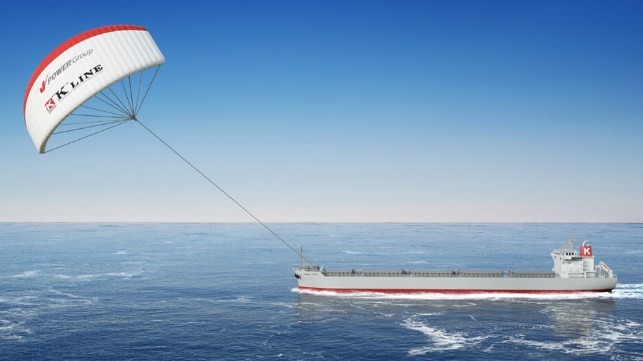“K” Line Bulker to Install Kite System for Wind-Assisted Propulsion

“K” Line working along with its partner Electric Power Development Company (J-Power) confirmed plans to move forward with what could become the first large, commercial installation of the Seawing, an automated kite system designed to provide supplemental wind-assisted propulsion. The system, which was developed in partnership with a French start-up Airseas, has been undergoing testing starting in 2022 with commercial production planned for 2024.
The Japanese companies reported that they will install the kite system aboard a four-year-old bulker, the Corona Citrus, owned by K Line and operated under charter to transport coal for J-Power. The 88,700 dwt vessel is currently operating between Newcastle, Australia and Osaka, Japan. It is 751 feet long. No timeline was announced for when the installation would be completed.
Airseas is a spinoff from France’s Airbus that started in 2013 to investigate ways to transfer Airbus’ expertise to the maritime sector. A prototype of the kite system was installed at the end of 2021 aboard a RoRo vessel, Ville de Bordeaux, which operates under charter to Airbus transporting major aircraft components. It is part of a two-year trial called Seawing4Blue that aims to fine-tune the system and serve as proof of concept. The 505-foot long Ville de Bordeaux (5,200 dwt), which is operated by Louis Dreyfus Armateurs, was testing 250 m2 and 500 m2 versions of the kite which flies more than 650 feet above sea level. The full-sized version will be 1,000 m2 (11,000 square feet).
Airseas previously said that it anticipates the Seawing will enable 10 to 40 percent fuel savings for vessels with an average of 20 percent using a combination of the kite and technology including a routing technology solution. Through a combination of flight, bridge, and deck computers, the Seawing flies dynamically on a figure-on-8 trajectory at over 100km/h, which according to Airseas generates 10 times more traction power than a static kite or sail.
The deck equipment enables the automated take-off and landing of the parafoil wing. It consists of a mast standing over 100 feet off the deck, trolleys, winches, and storage space. The wing is pulled out of the storage by the trolley system, before being inflated at the top of the mast for take-off. The flying equipment, which includes the parafoil wing, a flight control pod, and an umbilical cable, controls the automated and optimal flight of the wing. The wing is linked to the pod, which in turn is linked to the ship via the umbilical cable, handling traction, transferring data, and providing power to the pod. During the flight, the pod steers the wing to maximize the power of the system and ensure safety.
The system is fully automated with the three computers working in unison to digitally calculate scenarios and the wing adjusts its position depending on the wind direction and speed, as well as the ship speed and route.
K Line has been approved for trial projects under government-sponsored research efforts. Last year, the shipping company reported that it had extended its agreement with Airseas and planned to initially buy five systems. They said the first two would be installed on Capesize bulkers followed by three installations on post-Panamax bulkers.
In July 2021, JFE Steel announced plans to build and operate two 210,000 dwt vessels due for delivery in 2024 and 2025. The first LNG-fueled bulk carrier is being built by Nihon Shipyard Co. and will be operated by K Line and also incorporate the Seawing technology.
